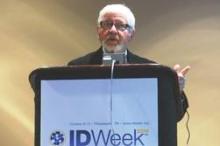PHILADELPHIA – Community associated Clostridium difficile infections continue to increase, rising most rapidly in children, a new study shows.
Age-related changes in C. difficile infection (CDI) also are being paralleled by age-dependent changes in the use of antibiotics, proton pump inhibitors (PPIs), and histamine type 2 receptor (H2) blockers, study author Dr. Howard Faden reported at an annual scientific meeting on infectious diseases.
Children aged 1-18 years had the highest use of antibiotics at 35.39%. This was followed closely by those younger than 1 year of age at 34.01%, who also had the highest use of H2 blockers at 4.30%.
“While children less than 1 year old may or may not develop community-associated C. difficile, their high rate of use of antibiotics and H2 blockers may be associated with higher rates of CD colonization. This could result in the spread of CD in the community,” said Dr. Faden, professor and chief of infectious diseases at the State University of New York at Buffalo.
Dr. Faden and his colleagues used New York State Medicaid data for an annual population of approximately 5 million recipients to calculate outpatient CDI and medication use from 2005 through 2012. Because CD is not considered a pathogen in the first year of life, infants younger than 1 year were included in drug use calculations, but not considered in the overall CDI analysis.
Over the study period, the overall annual incidence of community-acquired CDI increased significantly from 0.13% to 0.32% (P < .01), Dr. Faden said.
The highest incidence was among adults 65 years and older, increasing from 0.28% in 2005 to a peak of 0.54% in 2011, before declining slightly to 0.51% in 2012.
The incidence also increased in adults aged 19-64 years (0.10% -0.29%), but there was a “tremendous rise” in the diagnosis of community acquired CDI in children aged 1-18 years (0.01%-0.05%), Dr. Faden said.
“Granted, it’s much less than the adults, but the rise is much greater,” he remarked.
The differences between years were statistically significant for all age groups (P < .01).
For the total population, the annual use of antibiotics was 25%-35%, surpassing the use of prescribed PPIs at 7% and H2 blockers at 2.5%. “What’s startling to me is that roughly one in three patients in New York have had an antibiotic prescription in the preceding year,” Dr. Faden said in an interview. “When you consider that PPIs and H2 blockers are readily sold over the counter and our analysis accounts for only those that are prescribed, these are clearly underestimates.”
Notably, the use of two or three drug classes was significantly more common in CDI-positive than CDI-negative patients, regardless of age. The same relationship was not seen for one or no drug use.
Mayo Clinic in Minnesota also recently reported that the overall incidence of community-acquired CDI is increasing and that community-acquired CDI patients are significantly younger (median age 50 years) than those with hospital-acquired infections.
The study authors question, however, whether novel risk factors may be playing a role in acquisition, noting that 22% of all patients contracting CDI in the community had no prior antibiotic exposure, and 78% had no exposure to gastric acid suppression drugs (Am. J. Gastroenterol. 2012;107:89-95).
One of the novel risk factors may be having infants younger than 1 year in the household, Dr. Faden said in an interview. The frequent, but unsupported use of PPIs and H2 blockers in this age group further increases colonization, which can be easily transmitted through diaper changes. A study supports this theory, finding that patients with CDI and no or low-level outpatient health care exposure were significantly more likely to be exposed to infants younger than 1 year (JAMA Intern. Med. 2013;173:1359-67).
IDWeek 2014 is the combined annual meetings of the Infectious Diseases Society of America, the Society for Healthcare Epidemiology of America, the HIV Medicine Association, and the Pediatric Infectious Diseases Society.
Dr. Faden reported having no financial disclosures.


